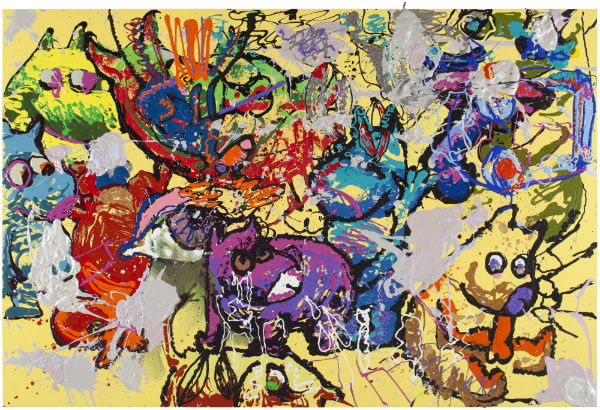Art & Exhibitions
artnet Asks: Serial Provocateur Bjarne Melgaard
The Norwegian artist speaks out following the child abuse controversy.
The Norwegian artist speaks out following the child abuse controversy.
Hili Perlson

Nothing is too sacred for Bjarne Melgaard. In his paintings, installations, videos, and mixed-media works, the New York-based Norwegian artist tackles drug addiction, sexual fetishes, self-destruction, psycho-sexual control games, and malevolent abuse of power, not without the occasional candy-colored stuffed-animal.
Melgaard’s hugely prolific output (he’s had eight solo shows since 2014, with two more coming up this year) is surely loud, trashed-out, carnal, and often filled with gratuitous homoeroticism, but beneath the brightly-colored chaos lurk dark observations about human behavior at its lowest and most abject. His works mirror our conspicuous consumption—of imagery, information, stuff— and reveal an intimate attraction to nihilism.
A recent show titled “Melgaard + Munch / The end of it all has already happened” on at Oslo’s Munch Museum earlier this year was reported to the police for alleged child abuse, because of a video from 2000 showing a man with a baby’s arm in his mouth (see Bjarne Melgaard Show at Munch Museum Faces Criminal Investigation).
Melgaard remained quiet on the Oslo controversy, busying himself instead with preparation for his new show, “Puppy Orgy Acid Party,” which opens at Galerie Forsblom today in Helsinki.
In the new series of paintings, Melgaard takes on the popular children animation characters, the Moomins—a Scandinavian staple of safe moral and political correctness channeled through a family of cute, white, bulbous hippos. Melgaard, unsurprisingly, dug deeper into the conditions of their creation, focusing on the tripped-out aspects of the beloved children’s show.
In your 2013 exhibition at Gavin Brown’s Enterprise “Ignorant Transparencies,” you showed the Pink Panther smoking a crack pipe. That figure has always had darker undertones—the Pink Panther’s famous tune wouldn’t be out of place in a “gentlemen’s club.” But it’s hard to imagine the darker undertones of the oh-so-PC Moomin family.
In the show here in Helsinki I was way more interested in exploring the cultural heritage of this figure of the Moomin in both a Norwegian perspective and a Finnish one. It’s kind of an exploration of what the Moomin would be if he was on Acid or DMT, and the spiritual consequences of exploring those substances. Something that is the total opposite to the dark, drug-obsessed world of my Pink Panther show.

Bjarne Melgaard
Untitled 2015
Photo: Jussi Tiainen, Courtesy Galerie Forsblom
Your recent show at Norway’s Munch Museum came under fire before it even opened, and led to a police investigation. What did you think about everything that was going on with that?
I think the whole media frenzy in Norway was really only a very clear manifestation of a very repressed homophobia. I don’t think the epic media coverage of the exhibition and of me presumably showing child pornography would have happened if it was a heterosexual artist showing works with sexually charged content. Also, I think that removing off some of the dust from Munch in Norway is always going to provoke a cultural backlash caused by ignorance of what Munch really was in his own time. The whole thing felt a bit sad for Norway and its populistic viewpoints.
The curator Lars Toft-Eriksen stood firmly behind his decision to show your video All Gym Queens Deserve to Die, but the show’s title “The End of it Has Already Happened,” makes me wonder if you somehow had anticipated all the controversy?
Not at all. The whole spectacle really caught me by surprise. I had shown that movie 15 years ago and I really thought that the debate around it had finished at that time.
The notion of hysteria seems fitting to describe many aspects of your work: it’s reflected in its form, but it also relates to the reaction it sometimes inspires and in turn, the reaction it then comments on, like a cycle that feeds into itself, while grabbing from everything around it. Do you think we could be addicted to hysteria?
I don’t know if we are addicted to hysteria but there certainly is a hysteria around in the media world about art and what’s important or not or what is relevant or smart enough or complex enough. I think a big part of the art world really makes a profit out of people’s fear of coming off as stupid—something that is often hard to avoid.
You’ve recently designed your first fashion collection too, inspired by Catherine Breillat’s 2013 film “Abuse of Weakness.” What was it about her story of being taken advantage of by a deceitful lover that moved you, and why did you use clothes as the medium for that particular experience?
Well, I could really identify with that story, having boyfriends who cheated and stole tons of money from me, like what happens to Catherine Breillat in that movie, and I wanted to use something very specific in fashion, since fashion is usually about “Spring” or colors and stuff. I choose Catherine Breillat because I deeply admire her and think she is one of the most important cultural figures in France.
Frank Ocean just announced—via a photo on Tumblr—that his new album will be out in July. In the photo’s background, there’s a poster from a 2011 show you curated “After Shelley Duvall ’72 (Frogs on the High Line).” What is the connection between you, artistically and/or socially?
I really have no connections to Frank Ocean either socially or artistically but admire his strength to come out as a gay musician in the way he did.

The frog poster in the backgorund was produced by Melgaard in collaboration with art director Eric Wrenn and Brendan Dugan, founder of New York’s Karma
Image via: frankocean.tumblr.com
Bjarne Melgaard: Puppy Orgy Acid Party at Galerie Forsblom, Lönnrotinkatu 5, 00120 Helsinki, Finland is on view from April 10 through May 3.